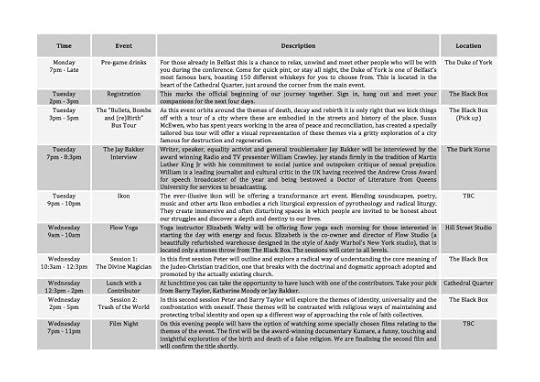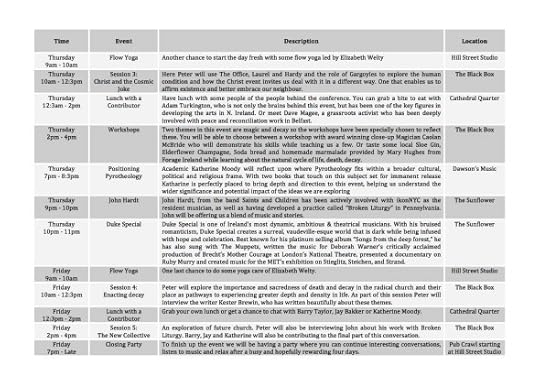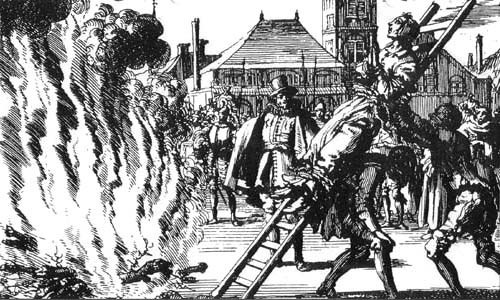Peter Rollins's Blog, page 35
April 15, 2013
Poets, Prophets and Preachers with Rob Bell
In 2009 I was invited by Rob Bell to give some talks at his Poets, Prophets and Preachers event. While there I gave two talks called “Returning to the New” and “Those with Ears to Hear.” Traversing a whole range of theoretical and practical issues the conference allowed me to explore a radical vision of future church. The seminars include an interview by Rob about my work, lots of me running around and a segway.
To download visit MissionSolutions, sign up then click on “The Peter Rollins Seminars”
Here is a low-res clip from the seminars
April 13, 2013
Idolatry of God Event
About six months ago I had an idea. I wanted to run a small retreat in my hometown of Belfast that would explore some themes developed in my last book. But as I started to plan I became convinced (through the guidance of a friend in the creative industry), that I should rather curate a type of mini-festival weaving together workshops, tours, music and talks. Although it would be a more costly and difficult thing to organize it seemed like something I needed to explore.
Well out of this grew the “Idolatry of God” event. A four day limited ticket event packed with music, films, talks, workshops and more on the theory and practice of pyro-theology. If this is a success I would be interested in running more, perhaps trying the same thing in the US. But for now I just wanted to share with you the timetable to show off what I have been slaving away creating over the last few months with the help of Seedhead arts.
If you’d like to see where everything is taking place just click here
If you’d like to see the Facebook page where we have been updating people on content click here
There are only a couple of tickets left, but if you’d one click here
March 23, 2013
Interview with Drew Marshall
This is an interview I did with Drew Marshall. Steve Stockman is first up and then I join in the conversation.
You May Not Believe in Ghosts, But Are You Scared of Them?
The great Illusionist Derren Brown recently asked an group of people to bring the picture of a loved one to a gathering (a cheap copy rather than some original). When people arrived at the venue with their pictures he held up a Satanic Bible and described an eleventh century rite contained within it. The rite itself was for people who wished to declare their allegiance to the devil. In exchange they would gain the protection of Satan, however it also meant that he would own their soul in the afterlife, torturing it for all eternity.
Part of the rite involved repeatedly stabbing the picture of a loved one while reciting some lines. What was interesting was the huge disparity between those who did not believe in the devil, or the idea that stabbing a picture of a loved one could have any effect whatsoever, and those who were willing to do the simple rite (a phenomenon well known in psychology).
There were one hundred and sixty people in the room but only eleven were willing to undergo the rite. The truly bizarre thing was that only six people in the whole room actually had any belief in the existence of the devil and the idea of supernatural powers, everyone else found the idea absurd.
What this exposes is the way in which we are able to enact a belief in our material existence without actually believing it at a conscious level.
It also shows that, in this audience of mostly secular individuals, religious belief was still operative at a material, repressed level. You can watch the experiment here (it happens in the first four minutes)
The practice of Radical Theology involves attempting to expose this repressed existence of superstitious belief within people and help to break it. The argument, in brief, is that the central scandal of Christianity is an invitation to give up such superstitious certainties at a material level and fully embrace the world without unconscious religious support. This means moving from the idea of super-nature to the super within nature i.e. to an embrace and affirmation of the sacredness of existence freed from superstition. We see this move, for instance, with the early church activist Paul who wrote about how people could eat food sacrificed to gods (1 Corinthians 8: 4-13). What is interesting of course is that most of the people he was addressing, as part of this new movement called Christianity, did not believe in other gods. Yet still they were afraid to eat the food (hence Paul needed to tell them it was fine). This logic is beautifully captured in an old English saying that there was once an Englishman who was so brave, not only did he not believe in ghosts he was not even afraid of them.
The practice of Radical Theology (which must be distinguished from the theology found in most of the church today) is not aimed at our conscious belief or disbelief, but rather at helping to short-circuit the hardwiring that causes us to continue to believe without our (conscious) belief (and which makes society susceptible to the resurgence of superstition in forms like the New Age, Positive Thinking and Fundamentalism). In this way it helps us to see the world as magical rather than as a mundane collection of matter containing magic (something that Kester Brewin explores in his book After Magic: Beyond Super-Nature). This move cannot but remind us of the ancient notion of Incarnation: where matter is not a surface beneath which the sacred rests, but rather matter is the sacred.
The role of the Church in the Radical tradition then does not lie in simply getting people to embrace doubt, unknowing and complexity, nor in affirming existence and working towards the good. But in sounding out where our certainties exist in repressed ways and how our inability to embrace the world is often something that we are not even aware of. To understand the latter we simply have to acknowledge the reality that people are often depressed, yet don’t even realise it (Pyrotheology is in this tradition).
It is not uncommon for a person to go to a doctor because they are having trouble with heart palpitations, sleep deprivation etc. only to be told, to their surprise, that they are depressed. A common response to this can be disbelief followed by a defense that involves telling the doctor about how social they are: always being out with friends and family. The point, of course, is that frenetic social activity can be one of the signs of an unacknowledged depression. For it can hint at our inability to be alone with ourselves for even a few hours for fear of what we might find.
This is why Radical Theology has a message to those who consider themselves secular as well as to the religious. For superstitious belief continues to operate among those who say they do not believe in it.
Hence the Good News of the Radical tradition is simple: If you really want to lose belief then join the Radical church.
March 19, 2013
A Church of Non-Christians
One of the signs of a world-historical movement is that it spills over from its particular interests and unites previously separate groups. In other words, an influential movement speaks beyond the confines of its origin, crosses tribal boundaries and touches people who might otherwise have no connection with each other. For instance, the French Revolution and the Arab Spring both began in a particular place with a particular people but ended up having world transforming significance through impacting the lives of millions who had nothing to do with either.
One of the reactive ways that such a crossing of boundaries can occur is through the logic of scapegoating. What happens here is that previously detached or antagonistic groups are brought together through the use of a joint exclusion of some entity.
This can be seen clearly in the National Socialism of Nazi Germany where the conflicts and crises of the society were managed through the formation of a common enemy: the Jew. National Socialism was able to briefly bring a type of unity to the German people by focusing their attention beyond the internal problems to an external cause. The Jew was an enemy that needed to be destroyed, yet this figure actually played a vital role for the political powers by helping to obscure the problems that existed within the society at large. Here a radical outsider was created, someone who was nothing but a form of unwanted trash to be destroyed as soon as possible.
In contrast to this there are movements that are made up of outsiders, who are the trash of the world. These outsiders are rarely listened to, they are the invisible ones who exist in a state of constant eclipse. But there are times when their voice is heard, and when this happens the message is hard to ignore.
This is one of the reasons that Kester Brewin has written about Pirates. These people were called the “Villains of all Nations,” and despised by all powers. The Pirate ships were made up of former sailors and slaves who had been considered to be nothing by the rich monarchs of the day. They were only cogs in the wheel of commerce to be used while able and cast aside when spent.
But the Pirates gave voice to these voiceless masses. The pirates were the trash of the world who were able to welcome all into their democratic communities. They even took a symbol that was sketched beside the names of dead sailors and made it their own. They simply removed the wings of this symbol and created their flag: the skull and crossbones. This now communicated how they were indeed the dead (dead to society, meaningless to them), and yet they lived on.
Their message cut across all distinctions and still echoes today in the contemporary fascination with the image of the pirate. This disparate collective was made up of those who had been inside society but not of it. In this way they were the “nons,” i.e. a group defined by, and yet not incorporated into, the wider society. To be a non-Christian, non-Jew, or non-Muslim for example is to be defined by a particular identity (Christian, Jewish, Muslim) as not within that identity. You are related to it as that which stands outside it.
A contemporary example of such a community is AA. In AA the problem is not externalized, rather there is a recognition that the problem exists within the community. The other is not the trash, we are. It is then a community of outsiders, of those who feel themselves to be excluded, beyond help, at rock-bottom. AA is not built on scapegoating, but rather on being honest and courageous about ones own struggles and brokenness. Those who attend do not find unity in hiding from their conflicts, but in bringing them to the full light of day in a place of grace and acceptance. This is a community of the nons and the nobodies, of those in society, but also outside it.
It is difficult not to see the similarities here with the type of communities envisaged by the early church writer Paul who speaks of his people as the trash of the world (1 Cor 4:13) , as those who are in society but not of it (Romans 12:2), and as those who stand outside the identities of society (Gal 3:28).
This leads then to the rather strange idea that the type of communities faithful to the writings of the early church in a Christian culture would be made up of non-Christians. For to be defined as a “non-Christian” in a Christian culture means to be defined as the outsider, as one who has no place on the inside.
My own project involves attempting to develop these communities of the “nons” and the “nobodies,” pirate islands like AA where we meet together to speak our brokenness and frustrations, hopes and fears in an open, courageous and honest way.
As more and more groups live this out, these voices can and will start to be heard beyond the confines of the collectives where this is happening and have a transformative effect on society at large. These communities do exist, they always have. But they are often hidden away and hard to track down.
They also go by many difference names in different cultures. But one such name, which is a rather old and misused one, is “church”.
March 12, 2013
Spirit & Place Festival, Indianapolis, IN
DATE/LOCATION/TIME: Tuesday, April 9, 2013 at Shelton Auditorium, Christian Theological Seminary, 1000 w. 42nd Street, Indianapolis, IN 46208 – 6:30pm
Spirit & Place Festival, Lafayette, IN
DATE/LOCATION/TIME: Tuesday, April 9, 2013 at Shelton Auditorium, Christian Theological Seminary, 1000 w. 42nd Street, Indianapolis, IN 46208 – 6:30pm
March 10, 2013
Dawkins, Dennett and Hitchens: The New Theists?
Today the word “sacred” is employed to name a certain realm of life that can be contrasted with the secular. The idea here is that some object, area of life or geographical location can act as a “thin place,” i.e. a site where the transcendent shines through.
This approach to the sacred is ubiquitous in the contemporary situation and is borne witness to in the phenomenon of religious music, books and art, in the New Age interest in ley lines, the notion of Christian universities and in the embrace of artefacts believed to contain supernatural power. Here the religious or sacred is taken to be a sphere that can be identified in some way, visited, held or touched.
In contrast to this the work of theologian Paul Tillich reveals a different approach. For rather than seeing the sacred as some distinct thing (even the greatest thing), one can see it as the name we give to the affirmation of a depth dimension that can be found in all things.
In this way one does not attempt to place the sacred alongside reason, ethics or aesthetics, but rather sees the sacred affirmed in our heartfelt commitment to these. From this perspective, insofar as we affirm the world as wonderful, we express the sacred. It is as we show loving care and concern for existence, and as we participate fully in life, we proclaim the sacred even if we are not aware of it. This is somewhat similar to the way that everything we see proclaims the existence of light even though we likely have no direct cognisance of the light (for we are focused on what the light illuminates).
As such Tillich argued that a serious rejection of God (rather than a mere lack of interest in the subject) is a deeply sacred act. For when someone rejects the notion of God because of the wars that have been fought over that name, as well as the abuse, the fundamentalism and the ecological destruction that is bound to so much religion, they are demonstrating a profound concern for both people and the planet. As such their attack is directly testifying to a depth dimension in existence. The stronger their attack the more care and concern they are showing. In this very assault they are thus asserting, in a direct and visceral way, a commitment to the protection and promotion of life. The result is a proclamation of the sacred that is birthed from the same mother as the message found on the lips of the various poets and prophets in the Biblical text. To take one example, consider the words of Amos who cries out, in the name of God,
I hate, I despise your religious feasts; I cannot stand your assembles. Even though you bring me burnt offerings and grain offerings, I will not accept them. Though you bring choice fellowship offerings, I will have no regard for them. Away with the noise of your songs! I will not listen to the music of your harps. But let justice roll on like a river, righteousness like a never-failing stream!
It is because of this that both the theologian Tillich and the philosopher Heidegger each claimed that there is a form of atheism that is closer to the divine than the standard theism witnessed in the church. For wherever a concern of beauty, an embrace of life and a love of liberation are exhibited the sacred is proclaimed. In this way the passionate critiques of God propounded by the New Atheists can be seen as potent defences of the sacred. Defences that, at their best, are worthy of being called divine.
March 9, 2013
Explore Future Church: 23rd-26th April
Set in the creative hub of the historic city that is Belfast, the Idolatry of God event has been carefully curated to provide a stage upon which the most innovative and paradigm shifting evolution in Christian thought and practice can be presented. Calling into question the most basic assumptions concerning faith that are shared by theists and atheists alike a radical form of faith collective will be explored that has the potential of usurping the dying church in its currently existing form. This four day mini-festival of ideas represents the culmination of my work to date and will provide a forum to explore its future development.
Blending incendiary ideas with music, art, reflections and conversation we will create a hot-house designed to feed the intellect as well as speak to the soul. Award winning musician Duke Special, internationally acclaimed peace activist Jay Bakker, BBC TV and Radio journalist William Crawley and the academic Katherine Moody are among the participants, as well a some surprise guests yet to be announced.
I appreciate that flights to Ireland aren’t cheap and that your time is valuable. Indeed many people have wondered why I didn’t do this event in the US were we could have had a much bigger and more profitable event. But it is important for me to do this in the land where my work was forged and in the very site where we experimented with the development of ikon.
We often expect the new paths to snake out from the cultural centres of power. But the practice of pyrotheology, while deeply influenced by streams of thought coming from elsewhere, was born in Belfast. It didn’t arise in a cultural capitol, but in a land ravaged by a conflict that destroyed countless lives. A land that once seemed hopeless but that has recently experienced an unexpected renaissance. Because of this the city provides a perfect backdrop to explore the death of church and its potential resurrection. The story of death, decay and rebirth that we will be exploring in the sessions is one that mimics what we see in the very streets of Belfast.
I believe that this is an important event for everyone interested in Future Church. So if you can’t afford the cost, but are part of a community that might be interested in the ideas, then you might consider asking if they could help you finance the trip. Or, if you know someone who should be here and would like to help them please let them, and us, know. Alternatively, if you are an organisation that would like to sponsor this event, please let me know and we can use any money to help provide subsidies.
Click here to buy a ticket or click here to follow the Facebook event page (where you can get more information)
February 20, 2013
Peter Rollins's Blog
- Peter Rollins's profile
- 314 followers










